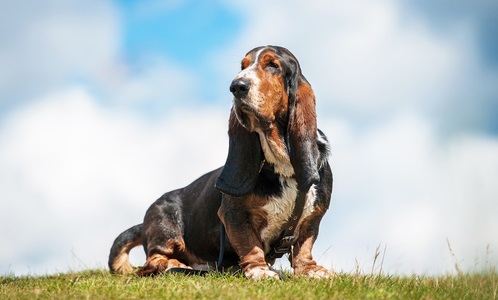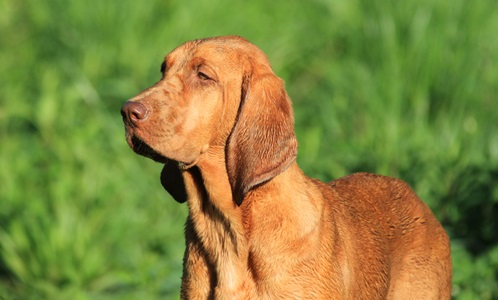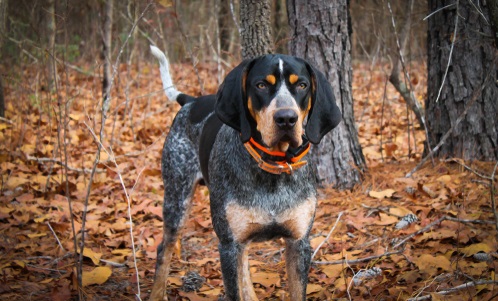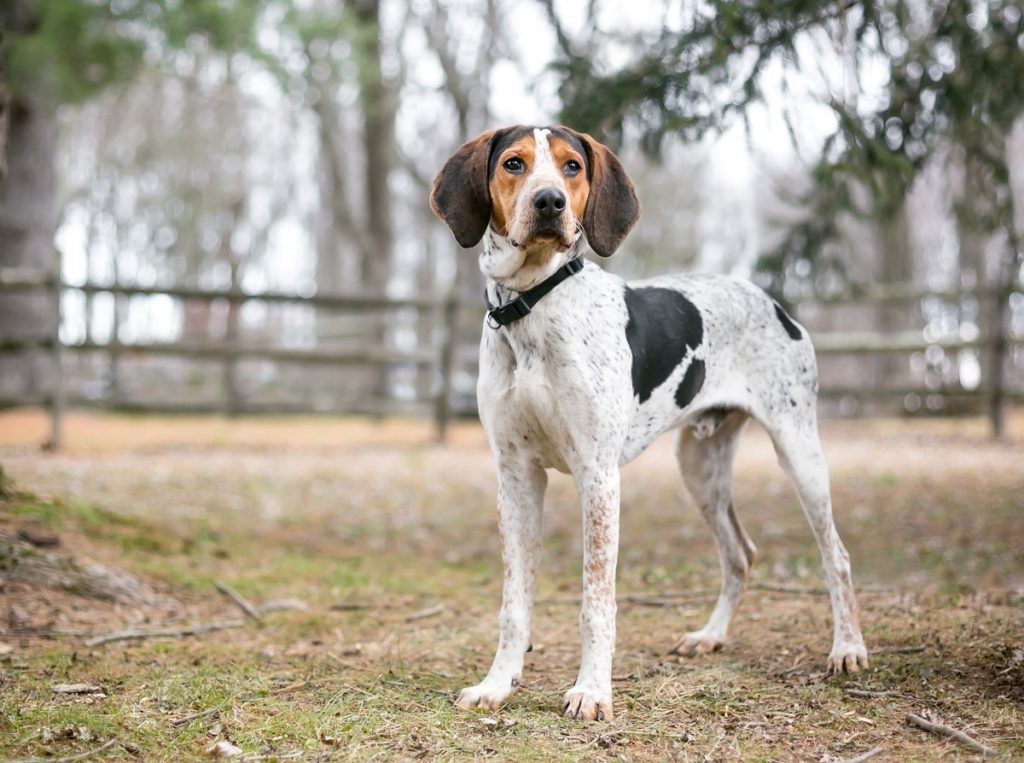For as long as history has had hunters, there have been hounds: loyal, hardworking canines that chased down prey and served their human masters. The shape, size, and specialty of a hound varies greatly depending on his birthplace and the work he’s bred to do, but universally the hound is a trustworthy companion that owners both cherish and admire.
The American Kennel Club, or AKC, recognizes no less than 32 of these breeds as being part of their “hound group.” While some may be familiar to hound fans, others may come as more of a surprise, given their diminutive stature or exotic looks. The one uniting factor of the breeds in the hound group is their origins: each were bred to hunt, flush, or track a particular type of quarry to aid their masters. Below are some of the most common types of hound dogs around today.
The American Hunting Hounds
 Woven into the fabric of US history, American hounds have long appeared beside their masters in paintings, photographs, and even in literature through classic stories. Extremely popular throughout the southern and mid-western areas of the country, these different types of hound dogs can now be found nationwide as companion animals as well as working dogs.
Woven into the fabric of US history, American hounds have long appeared beside their masters in paintings, photographs, and even in literature through classic stories. Extremely popular throughout the southern and mid-western areas of the country, these different types of hound dogs can now be found nationwide as companion animals as well as working dogs.
- Redbone Coonhound: The breed highlighted in the classic coming-of-age novel Where the Red Fern Grows, the Redbone is named for his hunting nemesis: the raccoon. His long ears hang all the way to his muzzle, and his strong legs and large paws make short work of even the most difficult terrain. Unlike some breeds, the Redbone Coonhound has only one recognized coat color: the deep rust red-brown that gives him his name.
- Treeing Walker Coonhound: While the classic tri-color pattern of his coat may be reminiscent of his hound “cousin,” the Beagle, the Treeing Walker Coonhound has a lot more height. As his name suggests, he’s a fast runner that’s particularly adept at cornering raccoons up trees for his hunting master to dispatch. His characteristic floppy, muzzle-length ears feature a slight rounding to the bottom edges.
- Bluetick Coonhound: One of the American-bred, raccoon-loving hounds, the Bluetick is enamored of hunting and it shows. They live to run and chase, and are best suited to a home and yard with plenty of room for them to stretch their long legs. Without proper exercise and attention, his owner might hear more than he’d prefer of the breed’s classic baying.
- Black and Tan Coonhound: The last of the coonhounds, the Black and Tan Coonhound shares distinct facial and body symmetry similarities with the Bloodhound, thanks to a “long” face and ears that hang below the muzzle. He has a very strong prey drive, and without proper training and enclosure, an owner might find him a bit headstrong if an unlucky squirrel crosses his path. His predominantly black coat is offset by warm brown tones in his “socks”, muzzle, and distinctive “pumpkin seed” dots at the corners of his eyes.
The English Hunting Hounds
 There are few more iconic companion animals than hunting hounds to the English. From the classic fox hunt to chasing down stags, the joyful bark of a canine hunting party is unmistakable. The long history of hunting in this region has given rise to some of the most popular hounds in the world through careful selective breeding, training, and standards.
There are few more iconic companion animals than hunting hounds to the English. From the classic fox hunt to chasing down stags, the joyful bark of a canine hunting party is unmistakable. The long history of hunting in this region has given rise to some of the most popular hounds in the world through careful selective breeding, training, and standards.
- Bloodhound: There’s a good reason the droopy-faced Bloodhound is often used as a mascot to represent sleuthing and solving mysteries: his incredibly powerful sense of smell can track almost anyone or anything across substantial distances. His long, floppy ears brush the ground and create a scent funnel that intensifies his talent for sniffing out scent traces, enabling him to track down everything from illicit substances to missing people.
- Beagle: Short, stout, and relentlessly energetic, the Beagle has an unmistakable “bay” or howl that differentiates himself from other types of hound dogs. His enthusiastic “awoo!’ is not only easy to hear, it ensures his master can quickly locate where prey has been spotted or chased down, even in dense forest. The Beagle plays hard and rests hard, making him an excellent companion for an active family that has the time to interact with him. His smaller-scale size marries the pleading-eye, floppy-eared look of hounds with almost puppy-like proportions, even in adulthood.
- English Foxhound: If the Beagle is recognizable for his shorter legs and long body, the English Foxhound distinguishes himself with long, slender legs and more proportional ears. His tail tells the tale of this alert, observant breed, often sticking straight up when something catches his eye. Capable of crossing wide distances quickly and built for running, a sturdy lead or careful training is a must with this speedy breed.
- Harrier: While his breed name might not inspire pleasant associations, this pack-thriving hunting hound was a favorable companion during medieval times. The Harrier brings together the lively personality of the Beagle with the powerful build of the English Foxhound, growing to a final size somewhere between the two. His almost-disproportionately long tail makes him easy to spot in dense brush.
- Otterhound: Although otter hunting is no longer legal, the strong, shaggy Otterhound still shows many of the traits he was bred for, such as a love of water and webbed feet to aid in swimming. His shaggy coat gives him a memorable look, but also provided padding and protection against the sharp claws of the otters he once chased away from commercial fishing areas in England.
- Greyhound: If any dog could be intrinsically linked to running, it would be the impossibly-sleek Greyhound, with his top speed of 45 MPH. Originally bred in England as a courser (hunting dog) that could keep pace with hunted deer, today this breed is famous for their commercial racing skills. While the Greyhound is adept at sprinting, he also makes an excellent apartment dog. Although commonly (and mistakenly) thought to be a hyper or hard-to-handle dog in domestic homes, he actually sleeps up to 18 hours a day and makes a loving companion.
- Whippet: If Greyhounds are the gentle, occasionally sleepy giants of the sleek English coursers, their Whippet cousins got the full measure of energy. While they, like Greyhounds, generally refrain from barking, they do need plenty of exercise. Whippets resemble Greyhounds in body shape but are generally noticeably smaller, with a shorter neck. A good lead and a sturdy fence is advisable with this breed since he can reach a top speed of 35 MPH.
The International Hounds
 While England and America have obviously made their mark among the recognized hound breeds, the rest of the world also offers up an intriguing assortment of these handsome canines. From Germany to the Middle East, these specimens of hound excellence are in a class all their own.
While England and America have obviously made their mark among the recognized hound breeds, the rest of the world also offers up an intriguing assortment of these handsome canines. From Germany to the Middle East, these specimens of hound excellence are in a class all their own.
- Dachshund: While badgers may be cute inclusions in a zoo today, they were once a real problem for farmers and landowners protecting crops. While the Otterhound was helping chase off weasel-like fish thieves in England, the Dachshund – a very short, very long breed – was performing similar work in Germany on English badgers. The word “Dachshund” means “Badger Hound” in German: the breed name points squarely to the bred task. Also called the “Doxie” or “Weiner Dog” among the pet parents that love them, the Dachshund is the undisputed king of his castle and comes equipped with plenty of attitude.
- Irish Wolfhound: As his name suggests, the original Irish Wolfhound was bred to take on his wild cousins, both for protection and proactive hunting. Today, he still has the hunting instinct in him, but the evolution of the breed has more to do with height and size than any natural ferocity. He has the distinction of being the tallest recognized AKC breed – the breed standard calls for a male height of 34 to 35 inches, while the infamously-large Great Dane breed is a slight step down at 30 to 32 inches. Big bones can bring on some big problems. Irish Wolfhounds can develop health issues like hip and cardiac problems. Which is why having soothing CBD dog treats on hand may be helpful with this breed.
- Saluki: Almost human-like with almond-shaped eyes and silky-furred ears, the Saluki sports an “inverted S” body shape that mimics the Greyhound and Whippet. Bred for and used as a hunting courser, the Saluki can run very quickly, reaching top speeds of 43 MPH, only 2 miles shy of the Greyhound.
- Rhodesian Ridgeback: Standing a substantial 35 to 27 inches at the shoulder, the Rhodesian Ridgeback is quite an impressive breed. Old wives’ tales herald this dog as an African lion-hunting dog. While the ‘Rhodie” was once used to track down lions, he didn’t take them on one-on-one; rather, he led his hunting masters to the quarry and let them finish the job. His trademark back-stripe of reversed fur gives him an almost primal appearance, but he actually has a very sweet temperament.
- Basset Hound: The Basset Hound is linked to the sport of hunting: originally bred in Belgium, this stocky hound is known for his sense of smell. His “scent funnel” ears closely resemble those of Bloodhounds and American Coonhounds, and his powerful legs push through dense brush with ease. His baying bark echoes that of the Beagle, and he is also frequently used in police work as a drug or tracking dog.
Other international hounds include Ibizans, Pharaohs, Sloughis, Scottish Deerhounds, and both the Petite and Grand variants of the Basset Griffon Vendéen, each more distinctive and intriguing than the last.
From shaggy and cold weather-ready to short-coated and heat-hearty, hounds have been appearing at their master’s sides throughout recorded history worldwide, and continue to dominate the list of AKC-recognized breeds while earning prestigious show awards. Loyal, hardworking, and determined, the hound’s zest for catching prey is rivaled only by the close bond he shares with his human companion.
Sources Cited:
1) “Hound Group.” American Kennel Club (AKC.org), (no publish date), https://www.akc.org/dog-breeds/hound/page/3/. Accessed November 21, 2019.
2) “List of Hunting Dog Breeds.” Dog Breed Info.com, (no publish date), https://www.dogbreedinfo.com/huntingdogs.htm. Accessed November 21, 2019.
3) The Editors of Encyclopaedia Britannica. “Hound Hunting Dog.” Encyclopaedia Brittanica (Brittanica.com), no publish date, https://www.britannica.com/animal/hound. Accessed November 21, 2019.




